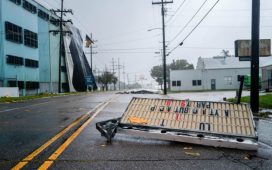As World Ocean Day rolls around again, it is hard to believe how much has happened since the last one. From the war in Ukraine to the death of entire languages, our understanding of how threats to the ocean reflect threats to humanity itself is constantly evolving. Here are some of the stories we have covered over the past 12 months.
Researchers have found that seaweed forests are far more extensive than previously realised. These underwater forests can act as a vital buffer against the climate crisis, absorbing carbon dioxide from seawater and the atmosphere. They could also help efforts to alleviate the world’s food security crisis. Yet they face multiple threats, including rising sea temperatures, pollution and invasive species.

Dolphins, egrets, herons and fish are among the casualties of Russia’s invasion of Ukraine. With some of the most intense fighting occurring on the southern coast, experts warned last year that marine and wetland environments along the Black and Azov Seas are under particular threat.
Over the past 15 years, insurance claims from severe weather events in Canada have more than quadrupled. People in some coastal communities now face a blunt reality: many homes are, in effect, uninsurable, and the changing climate will only make that problem worse in a country where most major cities are built along rivers and coastlines or on flood plains.

Fish farms have appeared offshore in many places around the world in recent years, sparking a heated debate about their impact on the planet and the welfare of fish. “There are obvious ways you can do it poorly,” says Steve Gaines, at the University of California, Santa Barbara. “But it can be done well, and the technology is there to do it well. It’s really important – it has lots of implications in terms of the next 30 years and more of the planet.”
Ahead of Cop27, Climate Visuals released a new collection of evidence-based images showing the impact of climate on marine environments. This selection shows everything from an upturned iceberg in the Weddell Sea to fishermen praying for a benevolent sea on the island of Dublar Char in Bangladesh.

More than 3m vessels are believed to be scattered across the ocean floor, offering tales of triumph and disaster that stretch back millennia. OceanGate Expeditions, which takes researchers and paying customers to the Titanic, envisions a frontline role for the shipwreck in demystifying how the oceans are changing. “How the ocean responds to climate change is going to dictate everything. We need to understand it,” says Stockton Rush, the company’s president.

“Many small linguistic communities are on islands and coastlines vulnerable to hurricanes and sea-level rise,” says Anastasia Riehl, director of the Strathy language unit at Queen’s University in Kingston, Ontario. Others live in areas where rising temperatures threaten traditional farming and fishing practices, prompting migration. “When climate change comes in, it disrupts communities even more,” she adds. “It has a multiplier effect – the final nail in the coffin.”
Vast fields of sargassum, a brown seaweed, have bloomed in the Atlantic. Fed by human activity such as intensive soya farming in the Congo, Amazon and Mississippi, which dumps nitrogen and phosphorus into the ocean, the sargassum explosion is by far the biggest seaweed bloom on the planet. The Great Atlantic Sargassum Belt, as it is known, is visible from space, stretching like a sea monster across the ocean, with its nose in the Gulf of Mexico and its tail in the mouth of the Congo River.

“I think I’ve replaced my climate-change anxiety with sargassum anxiety,” says Patricia Estridge, head of Seaweed Generation, a UK startup working to make seaweed commercially viable.
In south-east Asia, the health of marine and coastal ecosystems is in serious decline, but researchers and communities are joining forces to secure a future for coming generations. “We need to inspire people [to care] about our reefs. Together we can change the attitude of the past and work to make a difference,” says Ketut Gina in Bali, Indonesia, who collaborates with the Dutch conservation organisation Coral Reef Care and offers diving courses to people who want to work in marine restoration.
The Chumash people have spent decades fighting to turn 156 miles of coastline in central California into a national marine sanctuary, which would grant it federal protection. Not only would it preserve marine life, from sea otters to kelp forests, but the proposed sanctuary would safeguard Chumash traditions. If successful, it would be the first sanctuary on the US mainland nominated and led by a tribe.

The shipping industry was faced with the choice of switching to cleaner but pricier fuel, or installing a system to clean exhaust gases – known as “scrubbers” – that dump the chemicals removed from the exhaust directly into the sea instead.
Scrubbers are dirty and dirt cheap, but as of 2020 more than 4,300 ships globally had installed them – up from 732 ships in 2018. The cost of buying and fitting a scrubber is £1.5m-£5m, whereas cleaner fuel costs £250-£400 a tonne. The scrubber pays for itself within a year.
“It’s been a loophole for industry to continue burning the cheapest, dirtiest fuels,” says Lucy Gilliam, of Seas at Risk, an association of European environmental organisations.

For generations, the whale was an indispensable resource. Yet within just a few decades, half the global economy was restructured. Rarely in history has there been such a complete and radical reversal in the use of a natural resource. And, while humanity threw everything it had at the whale, most populations have now recovered to some extent.
It may be helpful to remember that what was needed, above all else, was for people to take an interest and get involved. The end of industrial whaling was an epochal change but, in retrospect, it came almost overnight.









